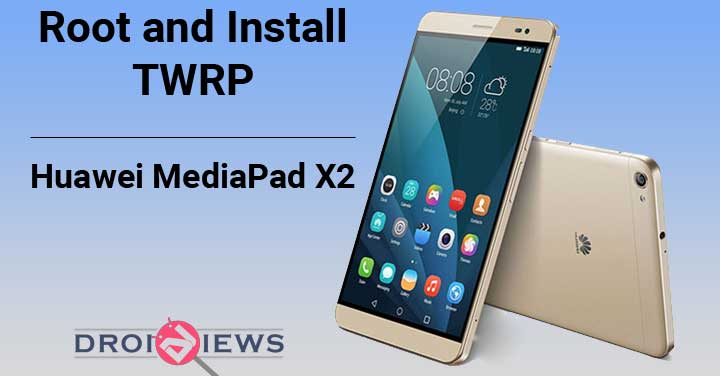
Huawei has been stepping up their game recently, especially with regards to design and build quality, pushing the limits of the phablet category with the MediaPad X2. It’s packing a 7-inch IPS display with a resolution of 1,200 x 1,920 pixels. Huawei has done what it can to cut the MediaPad down to size. It is super svelte at just 7.28mm, and the screen goes edge to edge with fairly minimal bezels top and bottom, which scores it a screen to body ratio of 80 percent. You can hold on to the device with one hand though, but its not going to be very comfortable, or possibly even fit, in your jean pocket. That said, Huawei’s focus on great design and build quality shines through once again with the Mediapad X2, and it is a wonderful device, regardless of whether you choose to use this as a phone or tablet, or both.
It comes with a laminated IPS LCD display with a resolution of 1920×1200, resulting in a pixel density of 323 ppi, which promises fantastic viewing angles up to 178 degrees, a 64-Bit, 2.0GHz Kirin 930 Octa-Core CPU, backed by a 64-bit GPU Mali-T628, as well as 2GB or 3GB of RAM depending on which version you choose. Internal storage of 16GB or 32GB is available, that also determines how much RAM you get, which is further expandable up to 128 GB via microSD card.
As it is with any new Android device that pops up in the market developers have the tendency to unleash Android’s full potential by gaining root access. A solution to bloatware, heavy UI skins, and other limitations can stop you from using them to their true potential. Rooting will give you back control over the look, feel, and behavior of your device. Following steps are gonna show you how to gain root access using a custom recovery on your Huawei MediaPad X2
Preparations
First of all you will need to ensure a few things before we start:
- Confirm you are using an unlocked Huawei MediaPad X2
If you’re using a locked model, check out this guide on how to Unlock the Bootloader of the Huawei MediaPad X2
Note: Carrier models might not work with this method. User is to perform this at their own risk.
- Ensure that you have the necessary Huawei drivers installed (Download here).
- Check if you have at least 80-85% of battery charge. We don’t want the phone dying in the middle of the process.
- If you have done this process before on other devices then you must be familiar with ADB and fastboot. Ensure that you have it installed.
For those who aren’t familiar with ADB and fastboot, Please refer to our detailed guide on How to Setup ADB and Fastboot on Windows within Seconds
- Enable USB-Debugging from Developer Options in the Settings menu.
- If you cannot find Developer Options, then you’ll have to first enable it by going to Settings -> About Phone -> Build Number and tap it 7 times until you see a small notification that you have enabled it.
- Then return to the Settings menu, you should find Developer Options there. Open it and enable USB Debugging.
- Make sure that you have backed up all your personal data and apps as all data might be erased!
- For Contacts, Calendar and People details use Google Accounts Sync to backup
- For Apps and App Data check out our detailed post here.
Disclaimer: The following procedure is highly risky and there are chances that you may brick your phone if not performed correctly, DroidViews cannot be held responsible if that happens. So the user should tread cautiously and at their own risk.
Downloads
You will need to download these files and save them on your Desktop.
TWRP for Huawei MediaPad X2: TWRP_3.1.1-0_DeepBlue_X2.img
SuperSU: Download Here
Flashing TWRP on your Huawei MediaPad X2
After preparing your device along with all the required files we can start flashing.
Step 1 – Connect your Huawei MediaPad X2 to your PC using the USB Data cable.
Step 2 – Open Command Prompt and type the following command
adb devices
You should be getting a message saying ‘List of devices attached’ along with your device name. This will confirm that adb has recognized your device.
If you don’t see your device it means you haven’t properly installed your device USB drivers.
Step 3 – Next reboot your device in fastboot/bootloader mode by typing this command in Command prompt
adb reboot bootloader
Step 4 – Now change the directory of your Command prompt to your Desktop by typing this command
cd Desktop
Step 5 – Type the following command next and press Enter
fastboot flash recovery <name of the .img file>
This will flash TWRP custom recovery on your Huawei MediaPad X2 replacing the stock recovery.
Step 6 – Once the flashing is complete, select RECOVERY from the Fastboot menu to enter Recovery Mode, use the volume keys to navigate.
Step 7 – If you see the TWRP logo, then you have successfully performed the steps on you now have TWRP custom recovery installed on your Sony Huawei MediaPad X2!
Step 8 – You will now see the TWRP Touch Recovery Menu, Select ‘Reboot’ to reboot you device and exit from the recovery.
Rooting the Huawei MediaPad X2
Now that we have successfully flashed the TWRP custom recovery you have the freedom to start flashing custom ROMs, kernels and other modifications, it’s time to move ahead and root the device, so that we can start using root applications.
Step 1 – Once the device boots up normally, re-connect it to you PC using the USB cable.
Step 2 – Copy the SuperSU.zip file you had downloaded earlier from your Desktop into the root directory of your internal storage.
Step 3 – Reboot you Huawei MediaPad X2 into Recovery Mode.
Step 4 – Select ‘Install’ and scroll all the way to the bottom till you see the ‘SuperSU.zip’ file.
Step 5 – Select the .zip file and swipe the bar to confirm. This will start flashing the .zip file.
Step 6 – Once the flashing finished you will see the ‘Reboot System’ option, click it to reboot your device.
Once the device reboots you will see the SuperSU app appear in your app menu. You can also confirm if your device is rooted by installing and running the Root Checker application.
[googleplay url=”https://play.google.com/store/apps/details?id=com.jrummyapps.rootchecker”]


Join The Discussion: